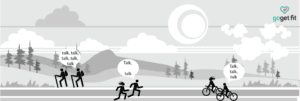GUEST BLOG POST – The Talk Test: How Intense is Your Physical Activity?
Written By GoGetFit Team


the Canadian 24-Hour Movement Guidelines recommend that adults perform “a variety of types and intensities of physical activity, which includes moderate to vigorous aerobic physical activities such that there is an accumulation of at least 150 minutes per week.”
This might seem a little vague or broad, but it’s worded this way to reflect the numerous ways there are to reach this number as well as the diverse capabilities, circumstances, and interests of our population. Importantly, you should incorporate many different types of activity into your weekly repertoire instead of, for example, simply doing five 30-minute runs per week. But, how do you know whether an activity is moderate, vigorous, or low intensity? The Canadian Society for Exercise Physiology defines moderate-to-vigorous physical activity, or MVPA, as “intense enough to increase heart rate and elevate body temperature. With MVPA, a person can talk but is unable to sing.”
At GoGetFit, we like to teach our users about the “talk test” as a simple way to measure the relative intensity of a physical activity. Relativity is crucial here because what is a moderate activity for you might be a vigorous or low-intensity activity for someone else. For example, a soccer player who runs a lot might find jogging to be a moderate-intensity activity, whereas it may be more vigorous for someone who is just starting to become active or enjoys other types of activities.
If you can speak comfortably during an activity you are in the low-intensity zone. As you head into moderate intensity – the minimum you want for a cardio workout – you should be able to talk but not sing. In the vigorous zone, you’ll only be able to get a few words out before you need to stop for a breath.
Though the talking test will determine how intense these activities are for you, some general examples for each intensity zone are:
Low intensity:
- Walking slowly, for example to the mailbox, on the way to work, or in a shopping mall
- Carrying grocery bags
- Stretching
Moderate intensity:
- Walking briskly (but not race-walking)
- Water aerobics
- A casual bike ride
- Tennis (doubles)
- Ballroom dancing
- General gardening
- Downhill skiing
- Shovelling snow
- Longboarding
Vigorous intensity:
- Race walking, jogging, or running
- Swimming laps
- Tennis (singles)
- Aerobic dancing
- Cross-country skiing
- Bicycling 16km per hour or faster
- Jumping rope
- Heavy gardening (continuous digging or hoeing)
- Hiking uphill or with a heavy backpack
Hitting the moderate and vigorous cardio zones is great for your heart and mental health. It’s important to aim to hit the moderate zone two or three times per week and the vigorous zone once or twice, even if you have to start with short 10-minute stints before building up to longer sessions. Trying to hit the vigorous zone – whether you get there or not – will benefit your heart. Just make sure you take adequate rest in between more intense activities.
In the end, breathing heavily and sweating for even 10 minutes translates to a happier and healthier heart. Now just get out there and start. Happy hearts and smiles!